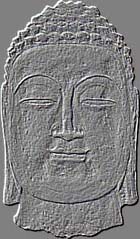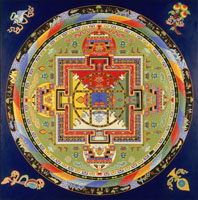Teresa Peña
Byrd Middle School
Exploratory ID Unit
HOME
Buddhism in Art

GOAL - To learn about the symbols of Buddhism and to make artwork using the symbols.
OBJECTIVE - Student will learn about the symbols that identify the Buddha or aspects of his life and teachings.
REFLECTION QUESTIONS - Why are symbols important? Do all representations of the Buddha have to look alike?What are some symbols used in your every day life?
Pre-Ap Art teachers will find links on this page useful for introducing Asian paintings and and Buddhist subjects.Understanding Asian art is sometimes difficult. You will be able to appreciate a painting once you learn how to find and read the story that is being represented. The following link takes you through the process of reading four different paintings.
Finding a story in painting with buddhist images
Five hundred years after his death, the first images of the Buddha started to appear. In order to recognize him there are certain areas that you need to recognize - hair, ears, eyes and neck. There are also five mudras, hand gestures, that have a special meaning.
Lo Monthang's Thubchen monastery went through a restoration process after years of disrepair. There is an article about the cleaning and restoration of the art in the monastery. You will also find an interactive page that shows the difference in a painting before and after.
THE MANDALA

Mandala means circle in sanskrit. Tibetan Buddhist use mandalas as a visual aid to help them practice meditation which brings about feelings of peace and well being. Mandalas are usually composed of millions of grains of colored sand. However, they may be made with rice, stones, jewels, and even butter. Mandalas can appear in two and three dimensional form.
The Mandala video link is a video from the Minneapolis Institute of Art. This video stream shows the planning and making of a Yamantaka Mandala. The monks will begin by making a blueprint of the design. Then, they will use tools called chakpus, thin metal funnels to distribute the sand. What is not shown is the dismantling of the mandala. This is done by sweeping away the sand to prove that all things are impermanent.
For a better understanding of mandalas, symbols, and vocabulary follow the link understanding the mandala.
Many lesson plans are available for creating mandalas. The link below offers many ideas and examples. The most creative and challenging are the mandalas made with photoshop. Look for the lesson entitled - Mandala unit in Computer Arts.
This is a mandala maze from a book called Tibet by Peter Sis. This maze might inspire students to create their own mazes.
This site was created byTeresa Peña at the NEH Summer Institute "Cultures and Religions of the Himalayan Region," held at the College of the Holy Cross, Summer 2004